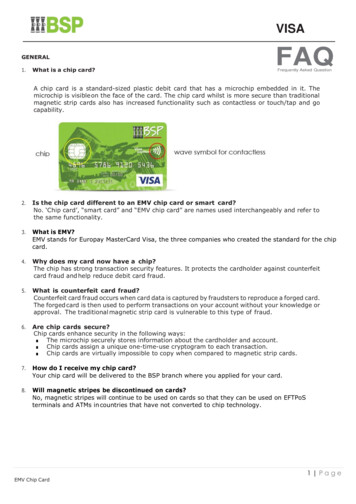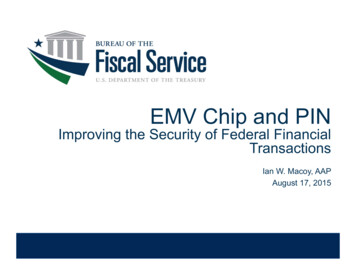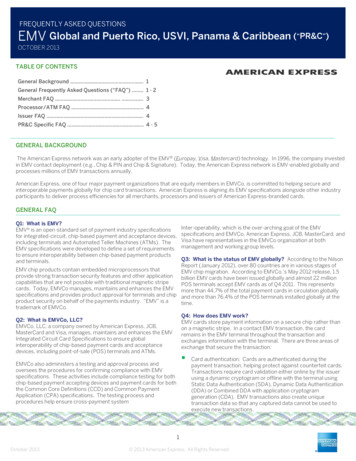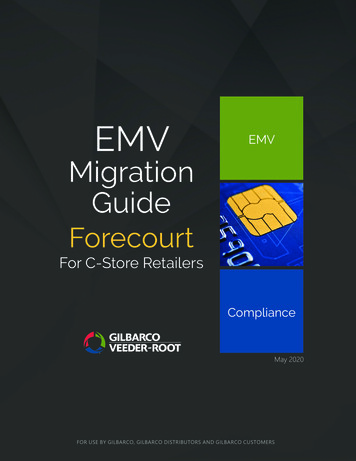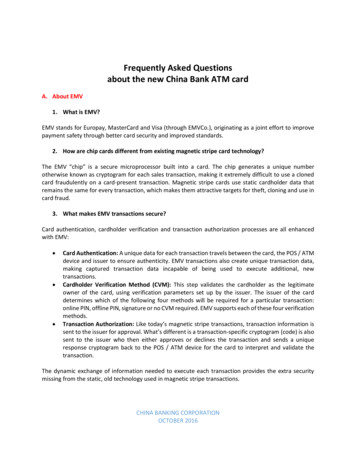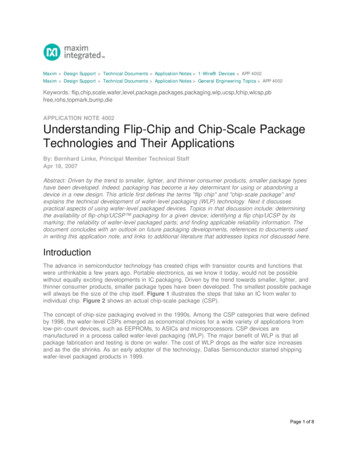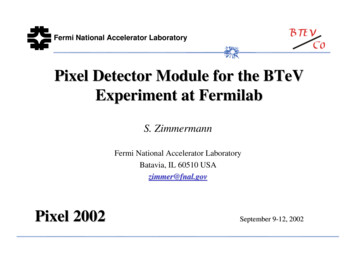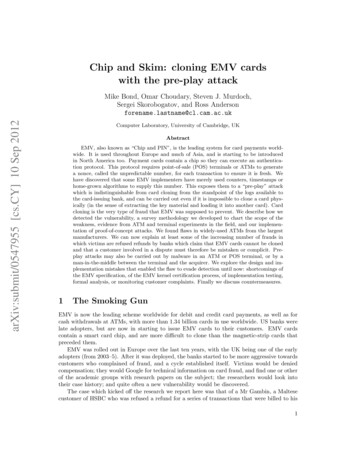
Transcription
Chip and Skim: cloning EMV cardswith the pre-play attackarXiv:submit/0547955 [cs.CY] 10 Sep 2012Mike Bond, Omar Choudary, Steven J. Murdoch,Sergei Skorobogatov, and Ross Andersonforename.lastname@cl.cam.ac.ukComputer Laboratory, University of Cambridge, UKAbstractEMV, also known as “Chip and PIN”, is the leading system for card payments worldwide. It is used throughout Europe and much of Asia, and is starting to be introducedin North America too. Payment cards contain a chip so they can execute an authentication protocol. This protocol requires point-of-sale (POS) terminals or ATMs to generatea nonce, called the unpredictable number, for each transaction to ensure it is fresh. Wehave discovered that some EMV implementers have merely used counters, timestamps orhome-grown algorithms to supply this number. This exposes them to a “pre-play” attackwhich is indistinguishable from card cloning from the standpoint of the logs available tothe card-issuing bank, and can be carried out even if it is impossible to clone a card physically (in the sense of extracting the key material and loading it into another card). Cardcloning is the very type of fraud that EMV was supposed to prevent. We describe how wedetected the vulnerability, a survey methodology we developed to chart the scope of theweakness, evidence from ATM and terminal experiments in the field, and our implementation of proof-of-concept attacks. We found flaws in widely-used ATMs from the largestmanufacturers. We can now explain at least some of the increasing number of frauds inwhich victims are refused refunds by banks which claim that EMV cards cannot be clonedand that a customer involved in a dispute must therefore be mistaken or complicit. Preplay attacks may also be carried out by malware in an ATM or POS terminal, or by aman-in-the-middle between the terminal and the acquirer. We explore the design and implementation mistakes that enabled the flaw to evade detection until now: shortcomings ofthe EMV specification, of the EMV kernel certification process, of implementation testing,formal analysis, or monitoring customer complaints. Finally we discuss countermeasures.1The Smoking GunEMV is now the leading scheme worldwide for debit and credit card payments, as well as forcash withdrawals at ATMs, with more than 1.34 billion cards in use worldwide. US banks werelate adopters, but are now in starting to issue EMV cards to their customers. EMV cardscontain a smart card chip, and are more difficult to clone than the magnetic-strip cards thatpreceded them.EMV was rolled out in Europe over the last ten years, with the UK being one of the earlyadopters (from 2003–5). After it was deployed, the banks started to be more aggressive towardscustomers who complained of fraud, and a cycle established itself. Victims would be deniedcompensation; they would Google for technical information on card fraud, and find one or otherof the academic groups with research papers on the subject; the researchers would look intotheir case history; and quite often a new vulnerability would be discovered.The case which kicked off the research we report here was that of a Mr Gambin, a Maltesecustomer of HSBC who was refused a refund for a series of transactions that were billed to his1
Chip and SkimBond, Choudary, Murdoch, Skorobogatov and Andersoncard and which HSBC claimed must have been made with his card and PIN at an ATM inPalma, Majorca on the 29th June 2011. In such cases we advise the fraud victim to demandthe transaction logs from the bank. In many cases the banks refuse, or even delete logs duringthe dispute process, leaving customers to argue about generalities. Some courts have recentlycriticised banks for this and in the Gambin case the bank produced detailed log data. Weobserved that one of the fields on the log file, the “unpredictable number” or UN, appeared tobe increasing 1241354F1244328F1247348The UN appears to consist of a 17 bit fixed value and the low 15 bits are simply a counterthat is incremented every few milliseconds, cycling every three minutes.We wondered whether, if the “unpredictable number” generated by an ATM is in factpredictable, this might create the opportunity for an attack in which a criminal with temporaryaccess to a card (say, in a Mafia-owned shop) can compute the authorisation codes needed todraw cash from that ATM at some time in the future for which the value of the UN can bepredicted. We term this scenario the “pre-play” attack.We discovered that several ATMs generate poor random numbers, and that attacks areindeed possible. Following our responsible disclosure policy, we informed bank industry organisations in early 2012 so that ATM software can be patched. We are now publishing the resultsof our research so that customers whose claims for refund have been wrongly denied have theevidence to pursue them, and so that the crypto, security and bank regulation communities canlearn the lessons. These are considerable. For engineers, it is fascinating to unravel why such amajor failure could have been introduced, how it could have persisted undiscovered for so long,and what this has to tell us about assurance. At the scientific level, it has lessons to teachabout the nature of revocation in cryptographic protocols, the limits of formal verification, andthe interplay between protocol design and security economics.The rest of this paper is organised as follows. In Section 2, we give the high-level background,telling the history of EMV and discussing its effect on fraud figures overall. In Section 3 wegive the technical background, describing how an EMV transaction works. Section 4 describesour experimental methods and results: how we developed a data capture card to harvest UNsequences from ATMs, and what we learned from examining second-hand ATMs bought oneBay. Section 5 presents our scientific analysis: what the crypto and security communitiesshould take away from this, how EMV can be made more robust, and how such failures can bemade less likely in future large-scale systems that employ cryptography for authentication andauthorisation. Finally in Section 6 we draw some conclusions.2BackgroundEMV (named after its original developers Europay, MasterCard and Visa) was developed inthe mid 1990s to tackle the developing threat of magnetic strip card counterfeiting, whereorganised crime gangs with access to card manufacturing equipment produced cloned cardsusing data from discarded receipts, or skimmed surreptitiously from legitimate cards, first atpoint-of-sale (POS) and later at automated teller machines (ATMs). The payment terminal2
Chip and SkimBond, Choudary, Murdoch, Skorobogatov and AndersonChip & PIN deployment period300 250 200 150 100Losses ( m) Card not present CounterfeitLost and stolen Cheque fraudID theft Online banking 2004Total, ex phone ( m) Phone banking 050Mail non 4.3529.6441410.6YearFigure 1: Fraud levels on UK-issued payments cardsexecutes the EMV protocol with the chip, which exchanges selected transaction data sealedwith a cryptographic message authentication code (MAC) calculated using a symmetric keystored in the card and shared with the bank which issued the card (the “issuer”). The idea isthat the bank should be able to detect a counterfeit card that does not contain this key, andthe physical tamper-resistance of the chip should prevent an attacker from extracting the key.Many countries, including the UK, moved to authenticating cardholders with a PIN ratherthan a signature at both POS and ATM, where previously PINs had only been used at ATMs.The goal was to make it harder to use a stolen card. This simultaneous introduction gave riseto the term “Chip and PIN” being commonly used in the English-speaking world to refer toEMV. In layman’s terms, the chip protects against card counterfeiting, and the PIN againststolen card abuse.EMV did not cut fraud as its proponents predicted. While using counterfeit and stolencards did become more difficult, criminals adapted in two ways, as can be seen from Figure 1.First, they moved to “card-not-present” transactions – Internet, mail-order, and phone-basedpayments – which remained beyond the scope of EMV.Second, they started making magnetic-strip clones of EMV cards. There had always beensome ATM “skimming” where crooks put devices on ATM throats to capture card data andrecord PINs; and now that PINs were demanded everywhere and not just at ATMs, the opportunities for skimming increased hugely. The simultaneous deployment of EMV with magneticstrip meant that fallback and backwards-compatibility features in EMV could be exploited; forseveral years, all ATMs would still accept mag-strip cards, and even once this started to bephased out in the UK for locally-issued cards, it was still possible to use mag-strip clones of UKcards in ATMs in the USA. This is why, soon after the completion of the UK EMV roll-out in2005, counterfeit fraud went up. Instead of entering PINs only at ATMs, customers were now3
Chip and SkimBond, Choudary, Murdoch, Skorobogatov and Andersonentering their PIN in POS terminals, which are much easier to tamper with [6].Total fraud levels were brought down following 2008 through improvements to back-endfraud detection mechanisms which reject suspicious transactions; by more aggressive tacticstowards customers who dispute transactions; and by reducing the number of UK ATMs thataccept “fallback” magnetic-strip transactions on EMV-issued cards. Fallback fraud is now hardenough to push the criminal community to more sophisticated smart-card-based attacks.Prior research showed that it was possible to use a stolen EMV card in a POS device withoutknowing the PIN. Given a suitable man-in-the-middle device, a crook can trick the terminalinto believing that the right PIN was entered, while the card thought it was authorising achip-and-signature transaction [14]; criminals have now gone on trial in France for exploitingthis “no pin” vulnerability [16].However, the “no pin” vulnerability does not explain the large number of people who havecontacted the authors having been refused a refund for a fraudulent ATM transaction whichthey adamantly deny having made. One such case was that of Alain Job who sued his bankfor a refund, but lost after the judge concluded that the customer’s card was probably used,not a clone [10]. In that case, the bank destroyed the log files despite the fact that a disputewas underway, contrary to Visa guidelines, and the judge warned that a court might not be sotolerant of such behaviour in the future.The number of such cases is unknown. The UK fraud figures quoted above only countlosses by banks and by merchants, not those for which customers are blamed; and since theintroduction of EMV, the banks have operated a “liability shift” as they describe it, whichmeans that when a transaction is disputed, then if a PIN was used the customer is held liable,while if no PIN was used the transaction is charged back to the merchant. This may be idealfrom the banks’ viewpoint but is less so for their customers. The 2008/2009 British CrimeSurvey [12] found that 44% of fraud victims didn’t get all their money back, despite both bankguidelines and the European Payment Services Directive requiring that customers who havenot acted negligently or dishonestly be refunded. Of the 44% who were not fully refunded fortheir losses, 55% lost between 25 and 499 ( 40 to 790) and 32% lost 500 or more. Sothere’s a large gap between the banks’ statistics and those from the crime survey. We believethat the vulnerability we expose in this paper could explain some of it.3Overview of an ATM transactionAn EMV transaction consists of three phases:1. card authentication in which card details are read and authenticated by the ATM orPOS terminal;2. cardholder verification in which the person who presents the card is verified whetherby PIN or signature; and3. transaction authorization in which the issuing bank decides whether the transactionshould proceed.The principals are the card, the ATM and the issuer1 . The process is illustrated in Figure 2.The description below has been somewhat simplified, and represents typical UK transactionflow. Other countries may differ slightly, but will be substantially similar.1 The bank that operates the ATM (the acquirer) and the network that links the issuer to the acquirer arealso involved in settlement, dispute resolution and assurance, but they do not participate in the authenticationprotocol run other than to route messages, so have been omitted from the discussion in this section.4
Chip and SkimissuerBond, Choudary, Murdoch, Skorobogatov and AndersonATMcardEMV commandprotocol phaseselect file 1PAY.SYS.DDF01available applications (e.g Credit/Debit/ATM)select application/start transactionsigned records, Sig(signed records)unsigned recordsSELECT/READ RECORDSELECT/GET PROCESSING OPTIONSCard authenticationREAD RECORD.Cardholder verificationT (amount, currency, date, TVR, nonce, .)ARQC (ATC, IAD, MAC(T, ATC, IAD))GENERATE ACT, ARQC, encrypted PINARPC, ARCARPC, ARCTC (ATC, IAD, MAC(ARC, T, ATC, IAD))Transaction authorizationEXTERNAL AUTHENTICATE/GENERATE ACTCFigure 2: Outline of an EMV transaction at ATM. Note that while the messages between cardand ATM have been verified, messages between issuer and ATM may vary depending on cardscheme rulesDuring card authentication, the card provides data records to the ATM, which includethe card number, start and expiry dates and which protocol options the card supports. Thecard also provides a static RSA digital signature over selected records, which aims to preventcrooks from fabricating cards from known or guessed account numbers. Some cards also providedynamic signature generation capabilities, known as “Dynamic Data Authentication” (DDA).Following card authentication, cardholder verification proceeds by signature or PIN. In anATM transaction the card is not involved in this verification. The customer enters their PINon the PIN pad, where it is encrypted and returned to the card issuer for verification throughthe ATM network.Finally, transaction authorization is carried out. The ATM sends to the card various transaction fields: the amount, the currency, the date, the terminal verification results (TVR –the results of various checks performed by the ATM), and a nonce (in EMV terminology, the“unpredictable number” or UN). The card responds with an authorization request cryptogram(ARQC), which is a cryptographic MAC calculated over the supplied data, together with somecard-provided data including the application transaction counter (ATC – a 16 bit number storedby the card and incremented on each transaction) and the issuer application data (IAD – aproprietary data field to carry information from the card to its issuer).The ARQC is sent by the ATM to the issuer along with the encrypted PIN. The issuerverifies the PIN and checks the ARQC by recalculating the MAC over the received data fields.Additional checks include whether sufficient funds are available, that the card has not beenreported stolen, and risk-analysis software does not flag the transaction as suspicious. Thenthe issuer returns to the ATM an authorization response code (ARC) and an authorizationresponse cryptogram (ARPC) destined for the card.The ARC authorises the ATM to dispense cash, which in turn passes the ARC and ARPCalso to the card. The card verifies the ARPC (which is typically a MAC over the ARQCexclusive-or’ed with the ARC), and returns an authenticated settlement record known as atransaction certificate (TC), which may be sent to the issuer immediately, or some time later5
Chip and SkimBond, Choudary, Murdoch, Skorobogatov and Andersonas part of a settlement process.POS transactions proceed similarly, except that cardholder verification is usually performedby sending the PIN to the card which checks it against a stored value. Whether the PIN isverified locally or online makes no difference to the attack discussed here. If a POS devicegenerates unpredictable numbers that can in fact be predicted, then it too will be vulnerableto a pre-play attack.3.1EMV pre-play protocol flawsThe card sends an ARQC to the ATM to prove that it is alive, present, and engaged in thetransaction. The ATM relies on the issuer to verify this and authorise the transaction. Simplyreplaying an ARQC should not work, because a competent issuer prevents replay by rejectingany transaction whose application transaction counter it has already seen. This prevents replayattacks but cannot assure the issuer that the ARQC was computed today rather than yesterday.To ensure freshness, a nonce is used – the unpredictable number (UN). This is a 32 bit fieldgenerated by the ATM.The first flaw is that the EMV protocol designers did not think through carefully enoughwhat is required for it to be “unpredictable”. The specifications and conformance testingprocedures simply require that four consecutive transactions performed by the terminal shouldhave unique unpredictable numbers [7, test 2CM.085.00]. Thus a rational implementer whodoes not have the time to think through the consequences will probably prefer to use a counterrather than a cryptographic random number generator (RNG); the latter would have a higherprobability of failing conformance testing (because of the birthday paradox).The latest version of the EMV specification [8, Book 4, p57] offers some guidance as tohow to generate the unpredictable number, but previous versions left the algorithm entirely upto implementers. Even the suggested construction (hash or exclusive-or of previous ARQCs,transaction counter and time) would not be adequate for generating a truly unpredictablenumber because the ARQCs would be zero if the ATM was rebooted and both the time andtransaction counter are predictable. Yet if the attacker can predict an “unpredictable number”ahead of time, he can harvest ARQCs from a card one day and use them at the ATM the next.The second flaw is that EMV does not include the identity of the terminal – a classic protocolmistake. While the EMV framework can support this through designation in a list of fields tobe MACed in the ARQC (the CDOL1), the standard format developed by Visa (the version10 cryptogram format [17]) requires only the terminal country code. The country in which theattacker will use its skimmed data is trivial to predict in advance. The implication is that ifthe attacker knows how to predict the UNs in a given make of ATM, he can harvest ARQCsfor use in any ATM of that type in a given country and at a given date in the future.These protocol vulnerabilities result in a “pre-play” attack – authentication data are collected at one moment in time, and played to one of a number of possible verifying parties atsome later time that is already determined when the data are harvested. The practical implementation is that a tampered terminal in a store collects card details and ARQCs as well asthe PIN from a victim for use later that day, or the following day, at ATMs of a given type.For example, in the case of the ATM in Palma that started this line of research, the counterrolls over every three minutes, so an attacker might ask a card in his store for twenty ARQCsat points in the 15-bit counter’s cycle. On visiting the ATM he could use his attack card tofirst calibrate the ATM’s counter, and then initiate transactions when the counter is expectedto be at a value for which he has a captured ARQC.This is all very well in theory, but is it viable in practice? We decided to find out.6
Chip and Skim4Bond, Choudary, Murdoch, Skorobogatov and AndersonExperimental Method and ResultsPre-play attacks against EMV have been discussed theoretically before, but for a real-worldattack to work, there are many practical challenges. In this section we describe our ownapproach to them: surveying for an exploitable vulnerability, skimming data, and deployingthe attack. Each stage of the process must be completed by criminals with reasonable yieldand an acceptably low cost (including probability of being caught).4.1Identifying vulnerable ATMsTo identify vulnerable ATMs we took three approaches: analysis of log files, collection of UNsin the field, and reverse engineering of ATMs.4.1.1Analysis of log filesWe regularly investigate ATM withdrawals on behalf of customers in dispute with their banks.In most cases the level of detail in logs provided by the bank is low, but in a minority of casesdetailed logs are handed over. The Palma case got us started on this research track, and wehave found one or two other cases of suspicious UNs in logs.Following our responsible disclosure of this vulnerability to the banks and card brands, wehave offered to help them analyse their log data, but have so far received little or no feedbackat all. We suggest that anyone in dispute with a bank over ATM transactions where thisvulnerability might be an explanation should subpoena the bank’s logs for analysis.We have also discussed the vulnerability with a large online services firm, but it turned outthat they do not retain records of the UN.We are particularly interested in collecting UN data from Italy, which is the only countryof which we are aware where UNs are routinely printed on all customer receipts.4.1.2Active probing of ATMsEven where ATM logs are available, the timestamps have an accuracy of only a second or sorather than a millisecond, so perhaps only grossly non-random UN generation algorithms canbe identified. For both researchers and crooks, a better data collection approach is required.This needs to be moderately covert as the public are aware of the problem of ATM skimming;using primitive analysis tools repeatedly at an ATM may be a way to get arrested.Therefore we constructed passive monitoring cards by adding a microcontroller to existingEMV cards. (For ethical and prudential reasons we informed the Metropolitan Police that suchexperiments were underway; we also consulted our local ethics process.) Care was taken toensure that the physical size of each card was not modified. The card remains a valid paymentcard – the transaction flow proceeds as normal – so it should always be accepted. However,it can be inserted into a variety of ATMs and POS devices without arousing suspicion. Moreprimitive approaches with trailing wires from the slot may cause problems in ATMs that holdthe card internally during reading. Figure 3 shows a payment card adapted with our circuitry.Other possible monitoring equipment includes wireless relay cards transferring data to a cardoutside, a wired card adapted to be compatible with ATM card slots, an overlaid shim glued atopa thinned-down existing card, or an ultra-simple shim consisting simply of an antenna suitablyconnected to the card data line (which we could observe using “TEMPEST” techniques).In the case of POS terminals, sales assistants are often briefed to turn away during PINentry and avoid handling the customer card. Thus existing monitoring tools such as the Smart7
Chip and SkimBond, Choudary, Murdoch, Skorobogatov and AndersonFigure 3: Passive monitoring card containing real EMV chip, with monitoring microcontrollerand flash storageCard Detective [2] have been proven suitable for surreptitious use with a hidden wire runningup the experimenter’s sleeve. We have used a similar tool to analyze unpredictable numbersfrom a POS terminal close to our offices, having the agreement of the POS owner.For each ATM investigated we harvested between five and fifty unpredictable numbers byperforming repeated balance enquiries2 and then a small cash withdrawal. The use of balanceenquiries minimises the number of withdrawals on the card, as sudden repeated withdrawalsmight trigger a fraud detection system and cause the card to be retained. Such cards cost a fewhundred pounds in component and labour costs so it is desirable to avoid their being capturedby ATMs.4.1.3Reverse engineering ATM codeWe were aware that black-box analysis of terminals through looking at lists of UNs would nottell the full story, so we acquired some ATMs for analysis. Figure 4 shows EMV-enabled NCRand Hanco/Triton ATMs acquired via eBay for 100 each. Some of these had been in recentservice, and some were out of service, having only been used for development. Barnaby Jack [9]describes how second-hand ATMs can be brought back into service easily by simply phoningfor a repairman.Reverse engineering a functioning and captive ATM can combine the best of black-boxanalysis with detailed work on the algorithms and also has the potential to expose weak pseudorandom number generators such as the C rand() function whose output might look acceptableto black-box analysis but is entirely predictable from a couple of recorded samples.We have yet to confirm the UN generation algorithm in any of the ATMs. Analysis hasbeen complicated by the obsolete architectures and our work is ongoing. One ATM was runningOS/2 (see Figure 5(a)), and another on primitive hardware based on the Zilog Z180 CPU (seeFigure 5(c)). We identified the manufacturer of the EMV kernel from information inside theATM, and documentation on their website [3] indicates that the EMV kernel requires seedingwith an external source of randomness. Hardware analysis revealed presence of a dedicated2 It seems all transactions at ATM are authenticated by EMV protocol runs, but some with a zero withdrawalamount.8
Chip and SkimBond, Choudary, Murdoch, Skorobogatov and AndersonFigure 4: ATMs acquired for reverse-engineering(b) Board with DES chip from Triton ATM(a) Extracting disk image from NCR ATM(c) CPU board from Triton ATMFigure 5: Detail of hardware reverse engineering9
Chip and SkimBond, Choudary, Murdoch, Skorobogatov and Andersoncrypto chip implementing DES (see Figure 5(b)) and we theorise also containing a hardwarerandom or pseudo-random number source. Currently we are confident that each byte of theunpredictable number is independently generated from an off-CPU resource. This would eitherbe the DES chip, a real-time clock (also present as a separate chip) or possibly the smart cardcontrol unit which is a MagTek board accessed via a serial interface.At the outset we believed that older, primitive platforms would be less likely to have a strongsource of randomness than modern platforms in all cases. However our broader research acrossATM and POS indicates a subtly different conclusion. Entirely modern platforms are likelyto call the typical OS resources for random number generation, which nowadays are relativelystrong. Meanwhile legacy platforms may have either strong or very weak randomness dependingon whether this issue was thought about by the designers at the time. Thirdly, legacy platformswhich have been ported to more modern environments are most likely to have weak randomnessas during the porting the random number generate custom call on the legacy platform is simplymapped across to the easiest standard library call, such as the C rand() function. In summaryit is as important to consider the lineage of the ATM or POS software as it is to consider thecurrent platform when estimating likelihood of vulnerability.4.2Analysing the RNGIn Section 4.1.2 we described our own approaches to data collection. Using this approach wecollected data to analyse the RNGs in EMV devices in our local area. We performed morethan 1 000 transactions across 22 different ATMs and five POS terminals. We were successfulat locating ATMs with weak RNGs, but attackers need to go further and identify which specificUNs are most likely to occur at a predictable future time. There are three broad classes ofineffective RNG to consider: an obviously weak RNG algorithm. This includes using counters or clocks directlyas the UN, homegrown algorithms which combine obvious transaction data, and severeprogramming errors which cause the state-space of a better algorithm to be limited (e.g.casting down to the wrong integer size, or submitting four BCD coded random bytesrather than four truly random bytes); a simple RNG with little or no seeding. There are many flavours, from a linearcongruential generator, through encryption of the clock, to more messy schemes wherewe may find some fixed bits and some bits that cycle, or where a state machine startsoff appearing random but ends up in a tight loop cycling through just a small numberof values. From an embedded systems standpoint the typical options are the C standardlibrary time() and rand() calls, neither of which have unpredictable outputs from acryptographic point of view; an RNG that can be put into a predictable state. The simplest failure modeis a strong RNG fed by a weak source of randomness that’s restarted on power-up, soan attacker can force an outage or follow the replenishment crew. There are also systems drawing noise from an untrustworthy source, such as when an RNG uses data fromprevious transactions. The attacker could insert a card which seeds known values, ortemporarily spoof the authorisation response from the bank, to push the RNG into apredictable state.Table 7(a) shows a selection of data collected from various ATMs falling broadly into thefirst category of ineffective algorithms. ATM1 and ATM2 contain a typical characteristic, which10
Chip and SkimBond, Choudary, Murdoch, Skorobogatov and AndersonSRC2 EXP6SRC2 0F5530B6EF34B0FE7507B0F3323630166E1Figure 6: Ten transaction sequences from a single ATMwe denote characteristic C, where the high bit and the third nibble of each UN are always setto zero. 11 of 22 ATMs we looked at exhibited this characteristic. Our current levels of
late adopters, but are now in starting to issue EMV cards to their customers. EMV cards contain a smart card chip, and are more di cult to clone than the magnetic-strip cards that preceded them. EMV was rolled out in Europe over the last ten years, with the UK being one of the early adopters (from 2003{5).
